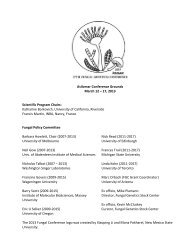Asperfest 4 Program - Fungal Genetics Stock Center
Asperfest 4 Program - Fungal Genetics Stock Center
Asperfest 4 Program - Fungal Genetics Stock Center
Create successful ePaper yourself
Turn your PDF publications into a flip-book with our unique Google optimized e-Paper software.
47. Putative G protein-coupled receptors GPRC and GPRD are involved in development and morphogenesis in Aspergillus<br />
1 1 1,2 1<br />
fumigatus. Alexander Gehrke , Thorsten Heinekamp and Axel A. Brakhage . Leibniz Institute for Natural Product Research and<br />
2<br />
Infection Biology - Department of Molecular and Applied Microbiology - Hans-Knoell-Institute, Friedrich-Schiller-University, Jena;<br />
eMail:alexander.gehrke@hki-jena.de<br />
The opportunistic human-pathogen Aspergillus fumigatus was subject to recent studies on cAMP signal transduction with regard to<br />
morphogenesis and virulence. To date, one of the most important questions is still unanswered: what are the external signals and the<br />
corresponding proteins sensing those ligands or stimuli which enable the fungus to grow in a wide variety of different ecological<br />
niches? In a first approach, two genes encoding putative G protein-coupled receptors gprC and gprD, designated as carbon sourcesensing<br />
receptors, were deleted in A. fumigatus. The physiological characterisation of the mutants revealed altered growth on solid<br />
media. However, various growth conditions, which included the use of different carbon- and nitrogen-sources, did not restore the<br />
defect of the mutants. Virulence of the mutant strains, as tested in a low-dose murine infection model, was attenuated. The function<br />
of the putative GPCRs was further investigated by analysing fluorescent protein-fusions in vivo by confocal microscopy. Recent data<br />
on the function of the receptors will be presented.<br />
1 1<br />
48. Transcriptional profile of Aspergillus fumigatus conidia in response to human neutrophils. Sugui, J. , Zarember, K. , Kim,<br />
2 1 2 1 1 1 2<br />
S. , Chang, Y. , Nierman, W. , Gallin, J. and Kwon-Chung, K. . NIH/NIAID, Bethesda, MD 20892 and The Institute for Genomic<br />
Research, Rockville, MD 20850.<br />
Neutrophils are cells of the innate immune system recruited to the sites of infection to phagocytose and kill microbial pathogens.<br />
Phagocytosis triggers the production of reactive oxygen species (ROS) as well as the fusion of cytoplasmic granules with the<br />
phagolysosome. We have previously shown that neutrophils from CGD patients, which generate little to no ROS, are capable of<br />
inhibiting Aspergillus fumigatus (AF) conidial growth as efficiently as neutrophils from healthy individuals. This suggests that the<br />
inhibition depends on non-oxidative mechanisms. We challenged conidia with normal and CGD neutrophils and analyzed the<br />
transcriptional profile. Analysis of the microarray data identified a group of 245 genes that were up-regulated in response to<br />
neutrophils. The majority of these genes were up-regulated in conidia but not in hyphae. A general classification of these genes<br />
showed that 26% are involved in transport, 17% in transcriptional regulation, 13% are related to peroxisomes, 12% in C1-C3<br />
metabolism and 9% in tricarboxylic/glyoxylate cycles. The increase in sugar transport and C1-C3 carbon metabolism suggests an<br />
increased requirement of carbon sources when conidia are challenged with neutrophils and fatty acids might be used as carbon source<br />
via the tricarboxylic and glyoxylate cycles. Real time PCR data confirmed the up-regulation of 3 genes involved in C1-C3<br />
metabolism; isocitrate lyase (a key enzyme of the glyoxylate cycle), a peroxisomal biogenesis factor and a NAD-dependent formate<br />
dehydrogenase. Studies are underway to investigate the biology of AF conidia inside human neutrophils.<br />
GENOME STRUCTURE AND MAINTENANCE<br />
1<br />
49. Transcriptome analysis of Aspergillus nidulans exposed to camptothecin-induced DNA damage. Iran Malavazi , Marcela<br />
1 2 3 4 5<br />
Savoldi , Sônia Marli Zingaretti Di Mauro , Carlos Frederico Martins Menck , Steven D. Harris , Maria Helena de Souza Goldman ,<br />
1 1 2<br />
and Gustavo Henrique Goldman . Faculdade de Ciências Farmacêuticas de Ribeirão Preto, Universidade de São Paulo, Brazil<br />
3 4<br />
Universidade de Ribeirão Preto, São Paulo, Brazil, Instituto de Ciências Biomédicas, Universidade de São Paulo, Brazil, Plant<br />
5<br />
Science Initiative, University of Nebraska, Lincoln, Nebraska, Faculdade de Filosofia, Ciências e Letras de Ribeirão Preto<br />
Universidade de São Paulo, Brazil.<br />
We have used an Aspergillus nidulans macroarray carrying sequences of 2,787 genes from this fungus to monitor gene expression<br />
ATR<br />
of both wild-type and uvsB deletion strains in a time course exposure to camptothecin (CPT). The results revealed a total of 1,512<br />
ATR<br />
and 1,700 genes in the wild-type and uvsB deletion strain respectively that displayed a statistically significant difference in at least<br />
one experimental time point. We characterized six genes that have increased mRNA expression in the presence of CPT in the wildtype<br />
strain relative to the uvsB mutant strain: fhdA (forkhead associated domain protein), tprA (hypothetical protein that contains<br />
ATR<br />
RAD51<br />
a tetratrico peptide repeat), mshA (MutS homologue involved in mismatch repair), phbA (prohibitin homologue), uvsC (RAD51<br />
homologue), and cshA (homologue of the excision repair protein ERCC-6 [Cockayne’s syndrome protein]). The induced transcript<br />
ATR<br />
levels of these genes in the presence of CPT require uvsB . These genes were deleted, and surprisingly, only the delta uvsC mutant<br />
strain was sensitive to CPT; however, the others displayed sensitivity to a range of DNA-damaging and oxidative stress agents. These<br />
results indicate that the selected genes when inactivated display very complex and heterogeneous sensitivity behavior during growth<br />
in the presence of agents that directly or indirectly cause DNA damage. Moreover, with the exception of UvsC, deletion of each of<br />
these genes partially suppressed the sensitivity of the delta uvsB strain to menadione and paraquat. Our results provide the first insight<br />
into the overall complexity of the response to DNA damage in filamentous fungi and suggest that multiple pathways may act in<br />
parallel to mediate DNA repair.<br />
Financial Support: FAPESP and CNPq Brazil<br />
4th International Aspergillus Meeting 20 Poster Abstracts











